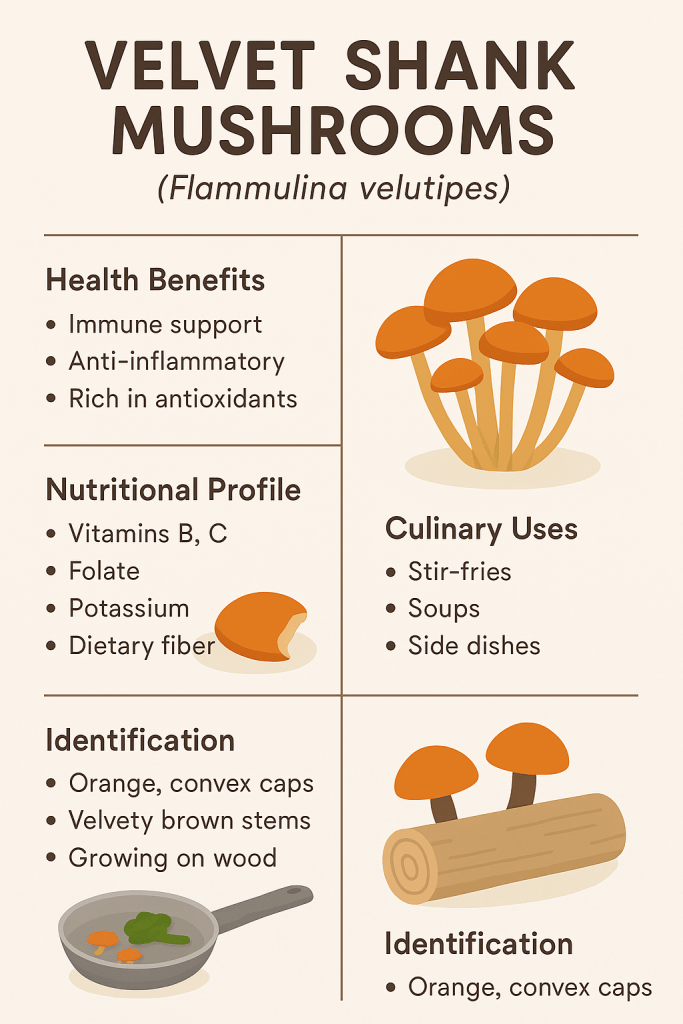Velvet Shank Mushrooms: Nature’s Winter Wellness Secret
Ever stumbled upon clusters of golden-orange mushrooms clinging to tree trunks in the colder months? Those are likely velvet shank mushrooms, and they’re more than just a pretty sight in the forest. In fact, they’re edible, full of nutrition, and widely appreciated in both wild foraging and traditional cooking.
From immune support to antioxidant properties, these mushrooms have a lot to offer — especially when the weather turns chilly.
What Are Velvet Shank Mushrooms?
Velvet shank mushrooms, known scientifically as Flammulina velutipes, are hardy fungi that grow during the winter. Recognised by their shiny orange-brown caps and velvety stems, they’re commonly found growing on dead or decaying wood, especially elm, ash, and beech trees.
Interestingly, these mushrooms are also cultivated under the name enoki in East Asia, where they appear as long, white, delicate mushrooms due to growing in the dark. Whether wild or farmed, their benefits are impressive.
Why Velvet Shank Mushrooms Deserve a Spot on Your Plate
Rich in Antioxidants
These mushrooms contain antioxidants that help the body fight oxidative stress. That’s the stuff responsible for cell damage and premature ageing. By including velvet shank mushrooms in your meals, you’re giving your body a natural boost against free radicals.
Immune System Support
Just like many other edible mushrooms, velvet shank contains compounds that may support immune function. They’ve been used in traditional medicine to help the body defend against colds and infections — especially in winter.
Current research highlights their potential role in promoting immune resilience.
High in Protein and Fibre
For a mushroom, velvet shank is surprisingly nutritious. It provides a modest amount of plant-based protein along with dietary fibre, which supports digestion and helps you feel satisfied for longer.
This makes it a great addition to vegetarian and low-calorie diets.
Contains Important Micronutrients
These fungi are a source of B vitamins, potassium, copper, and other essential nutrients. Adding them to your meals can help fill nutritional gaps, particularly in colder seasons when fresh produce is less available.
How to Prepare and Enjoy Velvet Shank
Foraged or Farmed — Clean Them Well
If you’re foraging, make sure to clean them thoroughly and double-check your identification. The shiny cap and dark velvety stem are key features. As always, if you’re unsure, consult an expert.
Farmed enoki versions are widely available in Asian supermarkets and can be used the same way, although their appearance differs.
Add Them to Winter Soups and Stir-Fries
Velvet shank has a mild, slightly sweet flavour and a pleasant texture when cooked. Try them in miso soup, stir-fries, risottos, or ramen. They soak up seasoning beautifully and bring a satisfying bite to broths.
Pair with Other Immune-Supporting Foods
Combine velvet shank mushrooms with garlic, ginger, or turmeric for an immune-boosting winter meal. These combinations not only taste great but also work synergistically for wellbeing.
Safety Tips and Considerations
While velvet shank is edible, always be cautious with wild mushrooms. Ensure correct identification, and cook them thoroughly to improve digestibility. Never eat wild mushrooms raw.
Also, if you’re new to eating mushrooms or have allergies, start with a small amount to see how your body responds.
Final Thoughts
Velvet shank mushrooms are a hidden gem in the world of wild edibles. They offer nutrition, seasonal immune support, and a tasty way to enrich your winter cooking.
Whether you find them on a walk or pick them up at your local market, give them a go in your next meal. You might be pleasantly surprised by their flavour and benefits.
For more natural health ideas, check out our article on Lions mane






